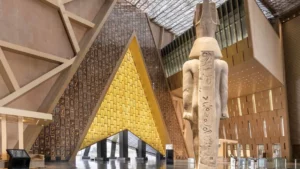6 Interesting Facts about Eritrea, an African Country Directly Bordering the Red Sea

Eritrea is an African country located close to the Red Sea. The location of the coast of Eritrea has long been an important place in its history and culture, as its name in the Italian version of Mare Erythraeum, Latin for “Red Sea.”
Quoting from the Britannica page, Monday, May 15 2023, the capital and largest city of Eritrea is Asmara. Eritrea is bordered by Sudan to the west, Ethiopia to the south and Djibouti to the southeast. The Red Sea to the east of Eritrea separates the country from the Middle East region.
In 1993, after nearly three decades of war for independence, Eritrea became a sovereign nation. During a long struggle, the Eritrean people managed to forge unity and overcome ethnic and religious differences to lift the country out of poverty.
There are still many interesting things about Eritrea, apart from its geographical location. Here are six interesting facts about Eritrea, summarized by Liputan6.com on Monday, 15 May 2023.
Countries Over the Red Sea
The Red Sea is the route by which Christian and Islamic missionaries reached Eritrea. Also, it was an important trade route that Turkey, Egypt and Italy hoped to gain, by seizing control of ports on the Eritrean coast.
The ports promised access to the gold, coffee and slave commodities sold by traders in the Ethiopian highlands to the south. In the second half of the 20th century, the Eritreans broke free from Ethiopia to create their own country.
Former Colony of Italy
Eritrea was once an Italian colony in the 19th century . Initially, the Italian territory was only in Assab after it was bought by an Italian businessman named Raffaele Rubatino. However, Italian territory continued to expand until it reached the borders of the Kingdom of Ethiopia.
Colonization that lasted for more than six decades has left a track record in the form of buildings and landmarks in Eritrea. It is not surprising that the capital city of Eritrea, Asmara, is also filled with Italian buildings that are unique and have their own characteristics.
9 Ethnicity
There are nine ethnic groups recognized by the Eritrean government. It is estimated that the Tigrinya people make up about 55 percent and the Tigre people make up about 30 percent of the population.
The majority of the remaining ethnic groups are Afroasiatic-speaking communities of the Cushitic offshoot, such as the Saho, Hedareb, Afar, and Bilen. There are also a number of Nilotic ethnic groups, represented in Eritrea by the Kunama and Nara.
Each ethnicity speaks a different mother tongue, but usually, many minorities speak more than one language. Rashaida Arabs represent about two percent of the Eritrean population.
Language in Eritrea
Eritrea has nine national languages, namely Tigrinya, Tigre, Afar, Beja, Bilen, Kunama, Nara and Saho. Tigrinya, Arabic and English serve as de facto working languages, with English used for university education and many fields.
Italian does not have government-recognized status in Eritrea. Italian is only spoken by a few monolinguals and Terdy Scuola Italiana di Asmara, an Italian government-operated school that closed in 2020.
Tours in Eritrea
Despite being a small country, Eritrea has a lot to offer its visitors, from its stunning landscapes and diverse culture, to its ancient historical sites and beautiful beaches. Especially in the capital, Asmara, there are many interesting buildings to visit.
First, Asmara Catholic Cathedral or the original name of the Cathedral of Our Lady of the Rosary. The church in the city center has been built since 1923 during the Italian colonization of Eritrea.
This church was built by the Italian Government in Eritrea due to the large number of Italian immigrants who arrived in the early 20th century. However, this church does not have a bishop so it cannot be called a cathedral.
Apart from the church, there is also its famous mosque, the Great Mosque of Asmara, which is the main and largest mosque in Asmara. This mosque was built by an architect named Guido Ferrazza in 1938 during the leadership of the Italian chassis.
Besides that, this mosque was also built on the initiative of Benito Mussolini in order to give a good impression to the Muslim community in Eritrea. This is because half of the population of Eritrea at that time embraced Islam.
Eritrean cuisine
Quoting TasteAtlas, there are several typical Eritrean dishes. First, zigni, which is a traditional dish with a spicy taste. This stew consists of diced beef, shallots, garlic, tomatoes and tomato paste, and is usually seasoned with a mixture of berbere spices, salt, pepper, lemon juice and coriander. It is recommended to serve zigni with injera flatbread on the side.
Although zigni is considered the national dish of Eritrea, it is also popular in Ethiopia, where it is known as kai wat. Apart from that, there is also the simple and flavorful kulwa which consists of chunks of lamb or beef deep-fried in berbere, ghee, tomatoes and onions.
This dish is traditionally served with rice or injera flatbread on the side, used to dip the delicious sauce. It is recommended to enjoy it with tej, the traditional honey wine.
For vegan dishes, Eritrea has hamli, consisting of sautéed mustard greens. First of all, the mustard greens are steamed until tender, then sautéed with a mixture of garlic, coriander, oil, shallots, parsley and tomatoes. The dish is sautéed until the mustard greens are really tender and full of flavour.
Source : liputan6





